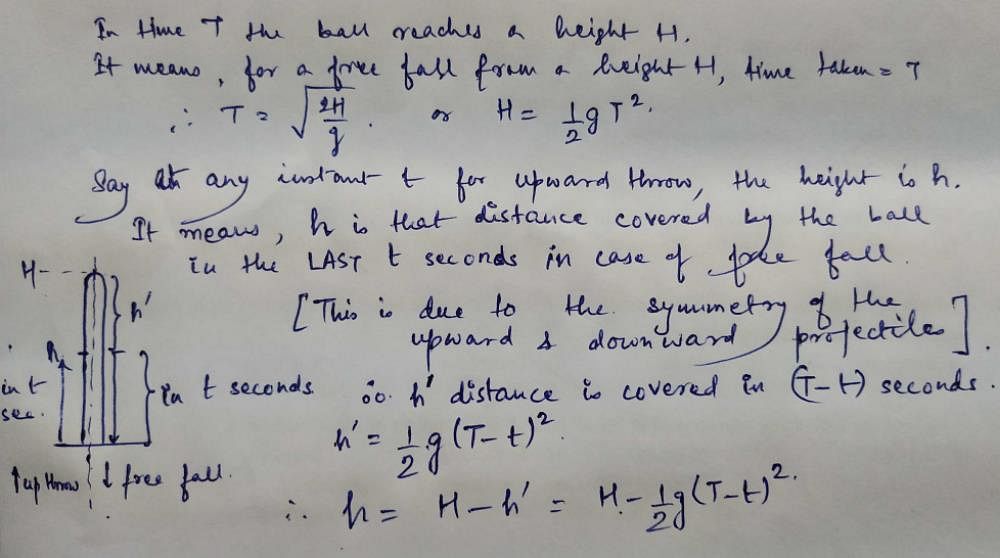JEE Exam > JEE Questions > A particle is projected vertically upward and...
Start Learning for Free
A particle is projected vertically upward and it reaches the max. height H in timeT second. The height of the particle at any time t will be ?
Most Upvoted Answer
A particle is projected vertically upward and it reaches the max. heig...
Height of a particle projected vertically upward at any time
When a particle is projected vertically upward, it follows a parabolic path due to the acceleration due to gravity. The height of the particle at any time t can be determined using the following formula:
h(t) = ut - 1/2 gt^2
Where:
- h(t) is the height of the particle at time t
- u is the initial velocity of the particle
- g is the acceleration due to gravity (approximately 9.8 m/s^2)
Calculating the maximum height reached by the particle
When the particle reaches its maximum height, its velocity becomes zero. Therefore, we can use the following formula to calculate the maximum height:
H = u^2/2g
Where:
- H is the maximum height reached by the particle
Calculating the time taken by the particle to reach maximum height
Using the formula:
H = ut - 1/2 gt^2
and setting the velocity at the maximum height to zero, we get:
T = u/g
Where:
- T is the time taken by the particle to reach maximum height
Conclusion
Therefore, the height of the particle at any time can be calculated using the formula h(t) = ut - 1/2 gt^2, the maximum height reached by the particle can be calculated using the formula H = u^2/2g, and the time taken by the particle to reach maximum height can be calculated using the formula T = u/g.
Community Answer
A particle is projected vertically upward and it reaches the max. heig...

Attention JEE Students!
To make sure you are not studying endlessly, EduRev has designed JEE study material, with Structured Courses, Videos, & Test Series. Plus get personalized analysis, doubt solving and improvement plans to achieve a great score in JEE.

|
Explore Courses for JEE exam
|

|
Similar JEE Doubts
A particle is projected vertically upward and it reaches the max. height H in timeT second. The height of the particle at any time t will be ?
Question Description
A particle is projected vertically upward and it reaches the max. height H in timeT second. The height of the particle at any time t will be ? for JEE 2024 is part of JEE preparation. The Question and answers have been prepared according to the JEE exam syllabus. Information about A particle is projected vertically upward and it reaches the max. height H in timeT second. The height of the particle at any time t will be ? covers all topics & solutions for JEE 2024 Exam. Find important definitions, questions, meanings, examples, exercises and tests below for A particle is projected vertically upward and it reaches the max. height H in timeT second. The height of the particle at any time t will be ?.
A particle is projected vertically upward and it reaches the max. height H in timeT second. The height of the particle at any time t will be ? for JEE 2024 is part of JEE preparation. The Question and answers have been prepared according to the JEE exam syllabus. Information about A particle is projected vertically upward and it reaches the max. height H in timeT second. The height of the particle at any time t will be ? covers all topics & solutions for JEE 2024 Exam. Find important definitions, questions, meanings, examples, exercises and tests below for A particle is projected vertically upward and it reaches the max. height H in timeT second. The height of the particle at any time t will be ?.
Solutions for A particle is projected vertically upward and it reaches the max. height H in timeT second. The height of the particle at any time t will be ? in English & in Hindi are available as part of our courses for JEE.
Download more important topics, notes, lectures and mock test series for JEE Exam by signing up for free.
Here you can find the meaning of A particle is projected vertically upward and it reaches the max. height H in timeT second. The height of the particle at any time t will be ? defined & explained in the simplest way possible. Besides giving the explanation of
A particle is projected vertically upward and it reaches the max. height H in timeT second. The height of the particle at any time t will be ?, a detailed solution for A particle is projected vertically upward and it reaches the max. height H in timeT second. The height of the particle at any time t will be ? has been provided alongside types of A particle is projected vertically upward and it reaches the max. height H in timeT second. The height of the particle at any time t will be ? theory, EduRev gives you an
ample number of questions to practice A particle is projected vertically upward and it reaches the max. height H in timeT second. The height of the particle at any time t will be ? tests, examples and also practice JEE tests.

|
Explore Courses for JEE exam
|

|
Suggested Free Tests
Signup for Free!
Signup to see your scores go up within 7 days! Learn & Practice with 1000+ FREE Notes, Videos & Tests.

























